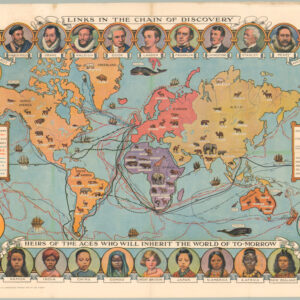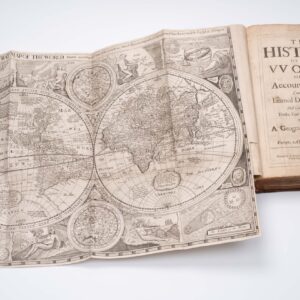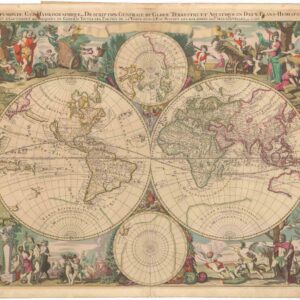Celebrating an empire that was about to disappear.
The Commonwealth of Nations, or The British Empire
Out of stock
Description
A gorgeous commemoration of British imperial history and power, produced on the occasion of George VI’s coronation.
In 1937, the British controlled an empire upon which it was said the sun would never set. This ornate planisphere unapologetically maps out the full extent of that Empire, or Commonwealth, in the early 20th century. The visual is dramatic, using everything from sharply contrasting colors and gilded highlights to loaded symbolism and ancient rhyme to garner the attention of its viewers. The purpose here is to underline the global import and power of the British Empire, while the occasion is the reconfiguration of its most important family.
In the center of the composition, we find a simple planisphere map of the world in a standard Mercator projection. On it, British imperial holdings have been outlined in red, while the rest of the world has been outlined in blue. In addition to these bright blues and reds, which make up the main color scheme of the poster, numerous features have been visually enhanced with golden ink to give the composition a luscious, almost regal feel.
Surrounding the map and kept in its rigid color scheme, we have five elaborate coats of arms and a medallion with four heraldic shields at the bottom. These coats of arms represent various aspects of the British Empire. The crest at the top of the composition is the United Kingdom’s Royal coat of arms. It is surrounded by a motto in Anglo-Norman, the French dialect of Old Norman spoken by the medieval ruling class in England.
The motto states Honi soit qui mal y pense, which means something to the effect of “Shame on whoever thinks ill of it.” In addition to being the crest of the Royal Family, this is also the credo of the chivalric Order of the Garter, the highest of all British knighthoods. Nevertheless, one can recognize the specific royal connotation in the subtext beneath: Dieu et mon Droit (God is my Right). This phrase refers to a common notion among European royalty that God himself ordained their right to rule. The flanking coats of arms refer quite explicitly to Britain’s African, Australian, and Pacific holdings.
In addition to the cartographic delineation of the Empire and the abundant imperial symbolism that pervades the imagery, the compiler of this chart added a final flurry to celebrate English greatness on the festive occasion of His Majesty’s coronation. We find textual excerpts from two distinct poets at the very bottom of the composition. On the left is a verse from John Milton, author of Paradise Lost and probably the most famous English poet of the 17th century. On the other side, a similar celebratory verse has been adopted from the great American troubadour Ralph Waldo Emerson. The choice of Emerson was not only related to the pertinence of the quote but also to the fact that the compiler of this magnificent view was, in fact, an American. The verses were written more than two centuries apart and serve to buttress the longevity of Britain’s global success. More importantly, however, they celebrate the Empire’s greatness:
Me thinks I see in my mind a noble and puissant nation rousing herself like a strong man after sleep, and shaking her invincible locks
– John Milton, from Areopagitica: a speech of Mr. John Milton for the liberty of vnlicens’d printing, to the Parlament of England (1644)
Britain – I see her in her old age but young – And still daring to believe in her power of endurance – With strength still equal to the time
– R.W. Emerson, English traits (1856)
Context is everything
Despite the extent of the British Empire in 1937, it is ironic that the entity being celebrated here soon would enter an inevitable spiral of decline and disintegration. The piece was compiled by Alonzo C. Webb for the Christian Science Monitor and issued with that publication on April 22nd, 1937. The occasion that prompted its creation and publication was nothing less than the coronation of George VI, planned for May of that year. His ascension and coronation had never really been in the cards, but after his brother, Edward VIII’s abdication in 1936, George was compelled to take the throne.
Despite his general misgivings about the role, not to mention a severe speech impediment that limited his public appearances, the new king would guide his people through the dark years of the Blitz and the nazi threat. When George died in 1952, the reigns passed to his daughter Elizabeth, who would oversee the complete dismantlement of Britain’s colonial empire, yet would rule the Commonwealth for more than seventy years. As this map was made specifically for the coronation of George VI, the verso includes a lovely presentation of the new Royal Family. On the left, we see a full-size photograph of George in uniform, whereas on the right are photographs of his two daughters, Elizabeth and Margaret. The entire thing is surrounded by a whirl of lively ornamentation recalling both medieval book illumination and the aesthetic force of the Arts & Crafts movement of William Morris and Charles Rennie Mackintosh.
In sum, this gorgeous piece of 20th-century history encapsulates many significant changes during the 20th century. It is an acutely romantic composition that speaks to some of the deeply-rooted problems of Western Civilization (e.g. colonialism, inherited power structures, and violent ideologies of dominance). Nevertheless, it is also a celebration of an old and venerable identity, not to mention a globalizing culture that, in many ways, remains unrivaled to this day.
Census
The Christian Science Monitor published the broadside on April 22nd, 1937. The OCLC lists copies of this map in four institutional libraries in the United States (no. 29303820), including Boston Public Library, the University of Michigan, Frostburg State University, and the University of Illinois at Urbana.
Cartographer(s):
Alonzo C. Webb (1888 – 1975) was an American draughtsman, architect, painter, and illustrator. Born in Nashville, Tennessee, he attended the Art Institute of Chicago and the University of Illinois, where he studied architecture.
Webb served with the U.S. Army Engineering forces in France during the First World War, and after the war, he was determined to stay there and make a life. He began an advertising company specializing in signs in English. During the 1920s, Webb became increasingly popular as an illustrator, producing work for prestigious publications in France and the United States.
In the 1930s, Webb moved to London, where he lived and worked for the rest of his life. During this time, he produced a celebrated commission by the Christian Science Monitor on the occasion of George VI’s coronation in 1937.
The Christian Science MonitorCondition Description
Very good. Some wear along edge and along centerfold. Gilded border and accents.
References
![[Dr. Seuss] This Is Ann….. She Drinks Blood!](https://neatlinemaps.com/wp-content/uploads/2024/05/NL-01354_thumbnail-300x300.jpg)



